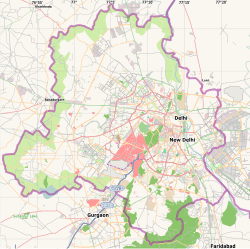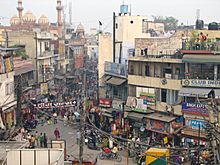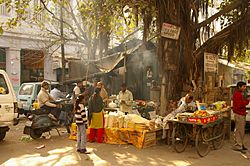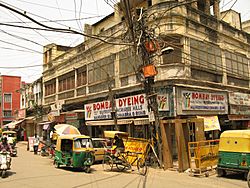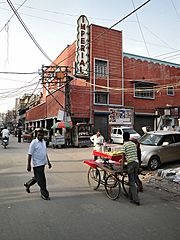Paharganj facts for kids
Paharganj, which literally means 'hilly neighbourhood', is a lively area in Central Delhi, located right next to the New Delhi Railway Station. Long ago, during the Mughal Empire, it was known as Shahganj, meaning 'King's market'.
Today, Paharganj is famous for its many affordable hotels, guesthouses, and restaurants. It's a popular spot for both Indian and international travelers, especially those on a budget, like backpackers. You can find all sorts of shops and enjoy many different types of food here. While it's a busy and exciting place, it's always good to be aware of your surroundings in crowded areas.
Quick facts for kids
Paharganj
|
|
|---|---|
|
Neighbourhood of Delhi
|
|
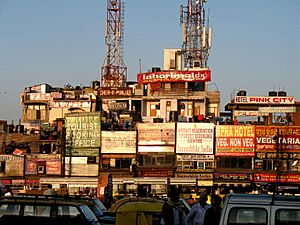
Paharganj hotels and restaurants, across New Delhi Railway Station
|
|
| Country | |
| State | Delhi |
| District | Central Delhi |
| Government | |
| • Body | Municipal Corporation of Delhi |
| Languages | |
| • Official | Hindi, English |
| Time zone | UTC+5:30 (IST) |
| Lok Sabha constituency | New Delhi |
| Vidhan Sabha constituency | Paharganj |
| Civic agency | MCD |
Contents
History of Paharganj
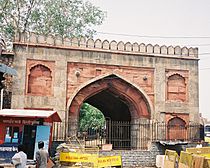
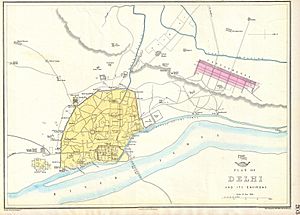
Mughal Era Beginnings
Paharganj has a long history, dating back to the 1600s. When Shahjahanabad (now Old Delhi) was built as the capital of the Mughal Empire, the city grew quickly. Many people lived outside the main walls. Paharganj was one of these important areas.
It was located just outside the Ajmeri Gate of the walled city. Paharganj was one of Delhi's five main markets, and the only one outside the city walls. It was a major place for trading grain in the 1700s. The name 'Paharganj' means 'Hilly neighbourhood' because it was close to Raisina Hill, where the Rashtrapati Bhavan (President's House) stands today.
In the 1690s, a general named Ghaziuddin Khan started a school called Madrasa Ghaziuddin Khan. This school later became the Zakir Hussain College. Part of the old school building still exists today.
British Era Changes
When New Delhi was being built in the 1920s, Paharganj also saw many changes. The old 'Imperial Theatre', built in 1930, is a reminder of that time. Some nearby areas were cleared to make way for Connaught Place, a big shopping district.
A place called Chai-Tuti-Chowk or Six Tuti Chowk became an important market square. It was named after six water taps that were originally there for the public.
A big change happened when the New Delhi Railway Station opened in 1926. Before this, only the Old Delhi Railway Station served the city. With the new station, many travelers came to Paharganj. This led to small restaurants and temporary places to stay opening up.
Over time, Paharganj became known for its budget hotels and restaurants. For example, a famous Shri Nand Lal Sharma dhaba (a roadside eatery) was set up in 1928. Later, it grew into a hotel called 'Metropolis'. "Shiela Cinema" in Paharganj was Delhi's first cinema with a 70mm screen.
After India's Independence
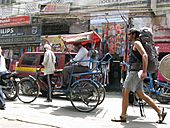
After India became independent in 1947, many people moved to Delhi. Paharganj grew a lot during this time, with new shops and businesses opening.
In the 1970s, Paharganj became a popular stop on the "Hippie trail". Many hippies and backpackers looking for affordable places to stay near Connaught Place, New Delhi and the railway station came here. This is why Paharganj still has so many budget hotels, cafes, and restaurants today, offering foods from all over the world. It even has a Chabad House for Jewish and Israeli visitors.
Paharganj is still a major hub for low-budget foreign tourists in Delhi. However, with more people and activities, the area has become very busy.
In 2005, a bomb blast happened in the main market of Paharganj during a busy shopping time, just before the festival of Diwali.
Before the 2010 Commonwealth Games, Paharganj received a big makeover. Many roads and lanes were improved, and shops were given a new look. This helped to make the area better for visitors coming for the games.
Historic Places to See
Paharganj is home to some interesting historic sites:
- The Qadam Sharif dargah is a shrine built by Firuz Shah Tughlaq, a ruler from the 1300s. It is dedicated to the footprint of Prophet Mohammed.
- The Qazi Wali Masjid is a mosque known for its beautiful designs and arched doorways.
- The grave of Zauq, a famous poet from the Mughal court who died in 1854, is also in Paharganj.
How Paharganj is Governed
Today, Paharganj is part of one of the 12 administrative zones of the Municipal Corporation of Delhi (MCD). The MCD is like the city council that helps manage Delhi.
Paharganj also has its own elected representative in the Delhi State Assembly. It is part of the New Delhi area for national elections.
Tourism in Paharganj
Paharganj has been known for its affordable hotels and shops, especially among backpackers, since the 1970s. It continues to be a popular choice for travelers looking for budget-friendly options and a wide variety of food and shopping experiences.
See also
 In Spanish: Paharganj para niños
In Spanish: Paharganj para niños
Images for kids


